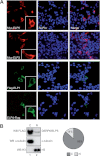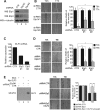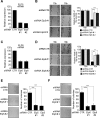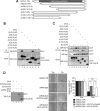DERP6 (ELP5) and C3ORF75 (ELP6) regulate tumorigenicity and migration of melanoma cells as subunits of Elongator
- PMID: 22854966
- PMCID: PMC3463322
- DOI: 10.1074/jbc.M112.402727
DERP6 (ELP5) and C3ORF75 (ELP6) regulate tumorigenicity and migration of melanoma cells as subunits of Elongator
Abstract
The Elongator complex is composed of 6 subunits (Elp1-Elp6) and promotes RNAPII transcript elongation through histone acetylation in the nucleus as well as tRNA modification in the cytoplasm. This acetyltransferase complex directly or indirectly regulates numerous biological processes ranging from exocytosis and resistance to heat shock in yeast to cell migration and neuronal differentiation in higher eukaryotes. The identity of human ELP1 through ELP4 has been reported but human ELP5 and ELP6 have remained uncharacterized. Here, we report that DERP6 (ELP5) and C3ORF75 (ELP6) encode these subunits of human Elongator. We further investigated the importance and function of these two subunits by a combination of biochemical analysis and cellular assays. Our results show that DERP6/ELP5 is required for the integrity of Elongator and directly connects ELP3 to ELP4. Importantly, the migration and tumorigenicity of melanoma-derived cells are significantly decreased upon Elongator depletion through ELP1 or ELP3. Strikingly, DERP6/ELP5 and C3ORF75/ELP6-depleted melanoma cells have similar defects, further supporting the idea that DERP6/ELP5 and C3ORF75/ELP6 are essential for Elongator function. Together, our data identify DERP6/ELP5 and C3ORF75/ELP6 as key players for migration, invasion and tumorigenicity of melanoma cells, as integral subunits of Elongator.
Figures







Similar articles
-
Structural insights into the function of Elongator.Cell Mol Life Sci. 2018 May;75(9):1613-1622. doi: 10.1007/s00018-018-2747-6. Epub 2018 Jan 13. Cell Mol Life Sci. 2018. PMID: 29332244 Free PMC article. Review.
-
Characterization of a six-subunit holo-elongator complex required for the regulated expression of a group of genes in Saccharomyces cerevisiae.Mol Cell Biol. 2001 Dec;21(23):8203-12. doi: 10.1128/MCB.21.23.8203-8212.2001. Mol Cell Biol. 2001. PMID: 11689709 Free PMC article.
-
Crystal structure of elongator subcomplex Elp4-6.J Biol Chem. 2012 Jun 15;287(25):21501-8. doi: 10.1074/jbc.M112.341560. Epub 2012 May 2. J Biol Chem. 2012. PMID: 22556426 Free PMC article.
-
Human Elongator complex is involved in cell cycle and suppresses cell growth in 293T human embryonic kidney cells.Acta Biochim Biophys Sin (Shanghai). 2009 Oct;41(10):831-8. doi: 10.1093/abbs/gmp072. Acta Biochim Biophys Sin (Shanghai). 2009. PMID: 19779648
-
Structural insights into Elongator function.Curr Opin Struct Biol. 2013 Apr;23(2):235-42. doi: 10.1016/j.sbi.2013.02.009. Epub 2013 Mar 16. Curr Opin Struct Biol. 2013. PMID: 23510783 Review.
Cited by
-
Elongator, a conserved complex required for wobble uridine modifications in eukaryotes.RNA Biol. 2014;11(12):1519-28. doi: 10.4161/15476286.2014.992276. RNA Biol. 2014. PMID: 25607684 Free PMC article. Review.
-
Loss of tRNA-modifying enzyme Elp3 activates a p53-dependent antitumor checkpoint in hematopoiesis.J Exp Med. 2021 Mar 1;218(3):e20200662. doi: 10.1084/jem.20200662. J Exp Med. 2021. PMID: 33507234 Free PMC article.
-
Role of ELP6 in tumour progression and impact on ERK1/2 signalling pathway inhibitors in skin cutaneous melanoma.Oncol Lett. 2025 Mar 26;29(5):250. doi: 10.3892/ol.2025.14996. eCollection 2025 May. Oncol Lett. 2025. PMID: 40177137 Free PMC article.
-
Plant Elongator-Protein Complex of Diverse Activities Regulates Growth, Development, and Immune Responses.Int J Mol Sci. 2020 Sep 22;21(18):6912. doi: 10.3390/ijms21186912. Int J Mol Sci. 2020. PMID: 32971769 Free PMC article. Review.
-
Loss of Ikbkap/Elp1 in mouse oocytes causes spindle disorganization, developmental defects in preimplantation embryos and impaired female fertility.Sci Rep. 2019 Dec 11;9(1):18875. doi: 10.1038/s41598-019-55090-1. Sci Rep. 2019. PMID: 31827135 Free PMC article.
References
-
- Otero G., Fellows J., Li Y., de Bizemont T., Dirac A. M., Gustafsson C. M., Erdjument-Bromage H., Tempst P., Svejstrup J. Q. (1999) Elongator, a multisubunit component of a novel RNA polymerase II holoenzyme for transcriptional elongation. Mol. Cell 3, 109–118 - PubMed
-
- Hawkes N. A., Otero G., Winkler G. S., Marshall N., Dahmus M. E., Krappmann D., Scheidereit C., Thomas C. L., Schiavo G., Erdjument-Bromage H., Tempst P., Svejstrup J. Q. (2002) Purification and characterization of the human elongator complex. J. Biol. Chem. 277, 3047–3052 - PubMed
-
- Wittschieben B. O., Otero G., de Bizemont T., Fellows J., Erdjument-Bromage H., Ohba R., Li Y., Allis C. D., Tempst P., Svejstrup J. Q. (1999) A novel histone acetyltransferase is an integral subunit of elongating RNA polymerase II holoenzyme. Mol. Cell 4, 123–128 - PubMed
Publication types
MeSH terms
Substances
Grants and funding
LinkOut - more resources
Full Text Sources
Medical
Molecular Biology Databases

